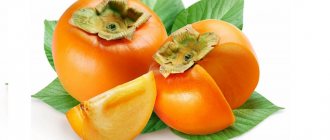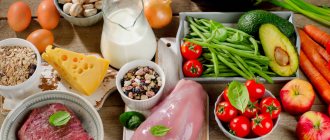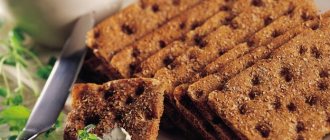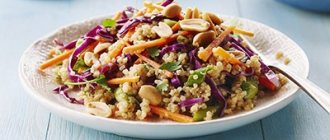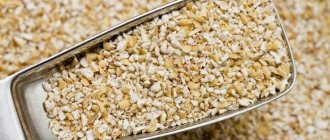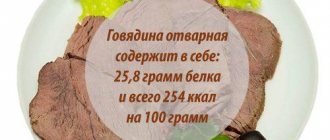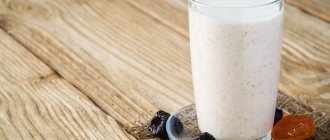Persimmon is a dietary product. The shape of the fruit is round, some varieties have the shape of a heart. The size of persimmon also depends on the variety and in some cases reaches 10 cm in diameter. The weight of the fruit ranges from 40 to 900 g. The average persimmon weighs 200-400 g. The peel is dense, the color can be different shades of orange, the thickness depends on the variety.
The energy value, that is, the ratio of BZHU (proteins, fats, carbohydrates), is 0.6/0.5/15.0. The calorie content per 100 g of persimmon is about 65 kcal; 1 medium-sized fruit contains about 250 kcal.
- Fasting day
Kinds
Persimmons (the calorie content of a weight loss product is given below in the article) are divided into tart and non-tart types depending on their origin. Tart ones have a soft, jelly-like consistency, astringent until ripening due to the large amount of tannin they contain. Such fruits are used as food and used in making jam and preserves.
Impatient - characterized by high density, elasticity and are suitable for preparing salads and dried fruits.
There are 6 varieties of persimmon:
- Kinglet. The most popular variety, characterized by light orange or dark brown flesh and the presence of seeds. The color of the seeds changes immediately after pollination and signifies the acquisition of softness and maturity of the fruit.
- Chocolate girl. A wren-like variety with a thin skin and a pleasant yellow or chocolate-colored pulp. The weight of one fruit is 250 g. There are grains inside. The variety withstands temperature changes well.
- Fig or chamomile. An early, fig-like variety with a small, flower-like shape. The flesh of the fruit is dark, the peel is yellow-orange or dark orange. It has a high sucrose content.
- Honey. The shape of the fruit is similar to a tangerine, has a sugary sweetish taste of the pulp and a thick peel. It contains a lot of fruit sugar, acquiring, after ripening, a jelly-like structure, which makes transportation very difficult.
- Bull's Heart . The fruits are distinguished by their very large size, tomato-like shape and moderate viscosity. The peel of the fruit is thin and very soft, which makes it very difficult to transport. A distinctive feature is also a delicate, less sweetish taste than other varieties.
- Sharon . A variety created by crossing a persimmon with an apple. It has a small shape and a dense structure, even after ripening. The peel of the fruit is rich yellow or orange. The pulp is light, non-astringent and seedless.
- Persimon . Oriental, very sweet variety, sourced from a subtropical climate. It has a dark orange color, a dense, non-jelly structure and a pleasant, very sweet pulp without viscosity.
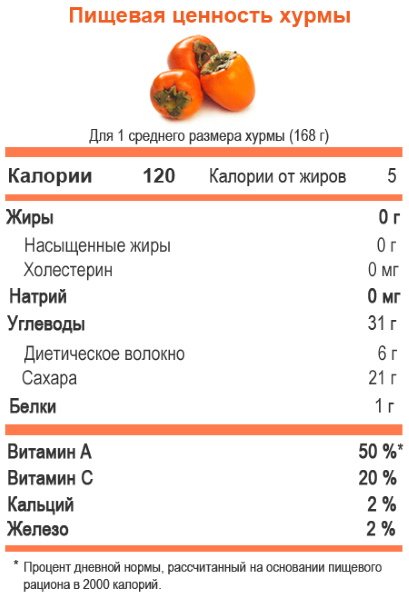
Calorie content and BJU indicators. The energy value of the fruit also varies depending on the variety.
| Variety | Calorie content |
| Kinglet | 76 kcal (66 per 100 g.) |
| Chocolate girl | 112 kcal (67 per 100 g) |
| Sharon | 135 kcal (69 per 100 g) |
| Bull's heart | 235 kcal (68 per 100 g) |
| Honey | 242 kcal (67 per 100 g) |
| Fig | 263 kcal (72 per 100 g) |
| Kaki | 302 kcal (67 per 100 g.) |
Calorie content, BJU, GI
Calorie content 100 gr. persimmon is about 66-67 kcal, which allows it to be used as a basis for a mono-diet. The weight of the fruit ranges from 40 to 900 g depending on the variety, but the average figures are about 200-400 g. The size of the fruit can reach up to 10 cm in diameter and varies depending on the variety.
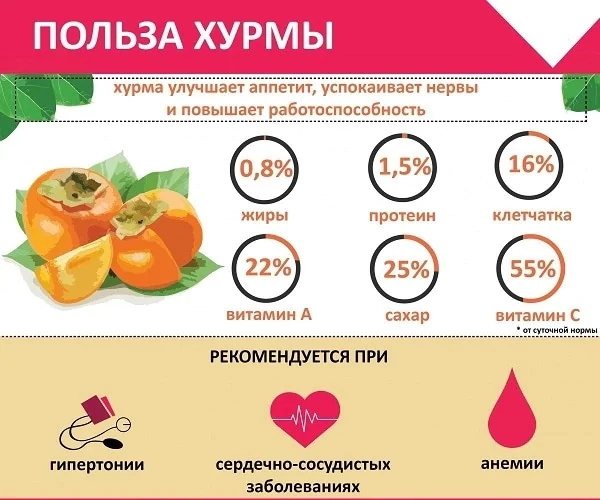
Chemical composition:
| Name | Quantity |
| Squirrels | 0.5 gr. |
| Fats | 0.4 gr. |
| Carbohydrates | 16.2 gr. |
| Alimentary fiber | 1.7 gr. |
| Water | 83 gr. |
| Hypoglycemic index | 45-50 (average) |
In addition to fresh fruits, you can eat dried or dried persimmons. The “food of the gods” prepared in this way is most often used for compotes or baked goods.
Dried persimmon tastes like figs and is obtained by drying the seedless fruit cut into slices at a temperature of + 45 degrees. The calorie content of such persimmons is only 94 kcal per piece. A distinctive feature of dried fruits is a bright white, indelible coating that appears when sucrose is released during drying.
You can prepare dried persimmon yourself by cutting the fruit into pieces and drying it in the oven for 1-2 hours. This fruit is added to pies or salads and contains only 84 kcal per piece.
Energy value:
| Type of persimmon | Calorie content |
| Dried persimmon | 93 kcal (235 per 100 g) |
| Dried persimmon | 84 kcal (246 per 100 g) |
How to store
Fresh persimmons can be kept at a temperature of 0...+1 °C for 2-3 months and usually this place is the refrigerator. A cellar would also do. But air humidity in any place should not exceed 87%. Fruits harvested for long-term storage do not need to be washed and the sepals also do not need to be removed. An open wooden box would be a good choice for storing fruit; if there are a lot of them, the layers are separated with sawdust and/or paper.
You can also preserve persimmons by freezing them. Ideally, pre-clean, discard the seeds and cut into slices. At a temperature of -18 °C it will last for 3 months. Frozen persimmons should be thawed at room temperature or by immersing the bag of fruit in warm water.
Dried fruits are also prepared from it - cut into slices and placed in an oven preheated to 45 ° C, and it is important to ensure that the slices do not darken too much. Can also be air dried. Dried fruits can be stored for 12-18 months. And it is worth noting that the benefits and harms of dried persimmons are almost the same as those of fresh ones.
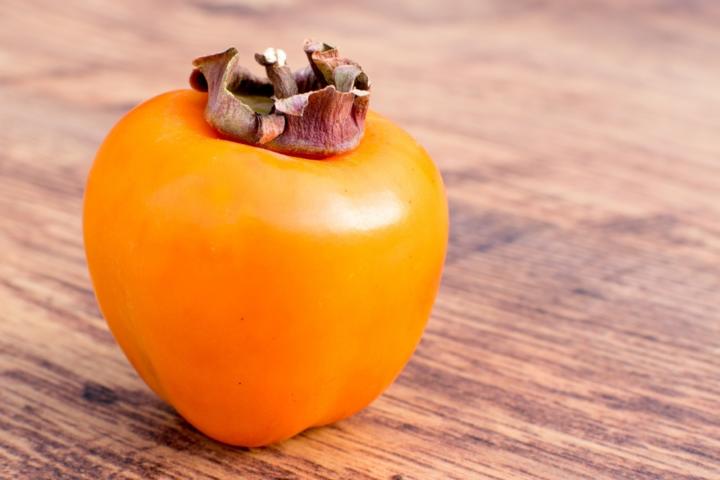
Benefit
Persimmon (the calorie content of the product for weight loss is sufficient and acceptable, which allows the fruit to be used as a tasty, dietary snack) is distinguished by a high content of various vitamins, macro- and microelements that contribute to the proper functioning of the body.
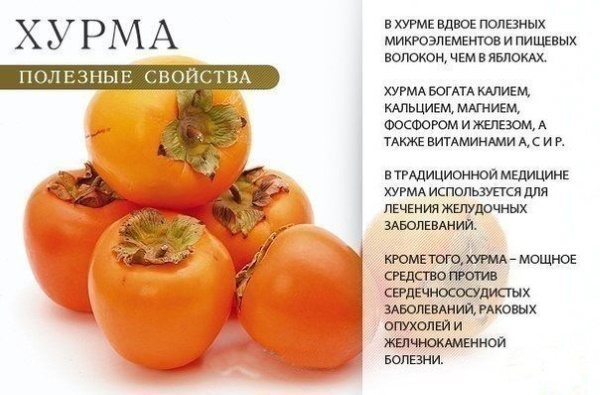
Nutrient content:
| Vitamins |
|
| Macronutrients |
|
| Microelements |
|
| Mono- and disaccharides |
|
Eating 2-3 fruits daily helps:
- due to the large amount of pectin, it has a gentle effect on the intestinal microflora, providing a bonding effect;
- improve blood condition and prevent iron deficiency anemia;
- tone the body and improve performance;
- normalize nervous activity and prevent the negative consequences of stress;
- nourish the heart muscle with potassium, preventing the occurrence of cardiovascular pathologies;
- replenish reserves of organic iodine, which is responsible for the normal functioning of the thyroid gland;
- due to the content of vitamins A, C and PP, protect cells from the effects of free radicals that provoke the development of oncological tumors;
- cleanse blood vessels and prevent the formation of cholesterol plaques;
- stabilize metabolic processes, promoting the rapid elimination of waste and toxic substances;
- prevent the formation of fossilized deposits and sand in the kidneys and gall bladder;
- improve visual function;
- activate cell regeneration processes.
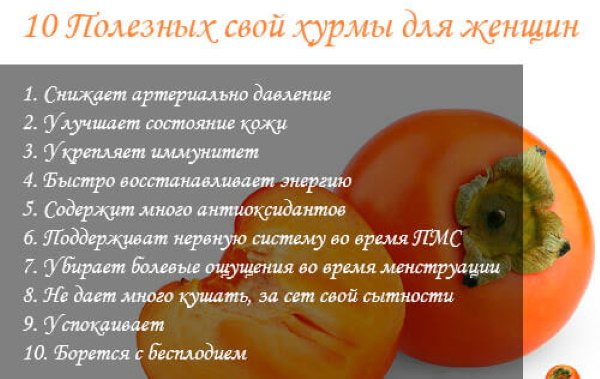
For coughs and colds, eating fresh persimmon helps boost immunity, and when rinsing the mouth with the infusion, it has a local antibacterial effect.
For men, regular consumption of persimmon helps cope with stressful situations and increased stress, as well as improve the condition of the excretory system and sexual function. A woman needs persimmon to regulate hormonal levels and reduce the severity of menopause symptoms.
Consumption of persimmon by pregnant women is recommended as:
- prophylactic against deficiency of iron, potassium, iodine and fluorine;
- assistance in creating a child’s bone skeleton;
- means that help remove toxic substances from the body and fight swelling;
- fruit that reduces the severity of toxicosis.
Persimmon applied to the skin has an anti-aging and nourishing effect, and also helps fight acne and flaking. You should eat persimmon 1-2 times a day, best in the daytime or evening. Consumption of the product on an empty stomach in the morning is not recommended due to the increased risk of constipation.
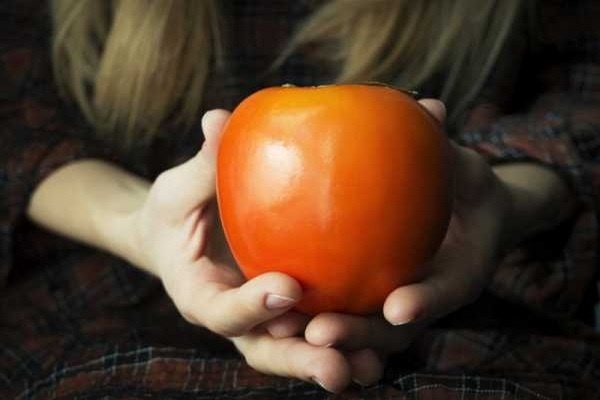
To remove viscosity, the fruits can be frozen for 2-3 hours, placed in boiled water for 10 hours, or pierced in several places with a needle previously placed in alcohol. Obese people are prohibited from eating persimmon before bed. You should not drink fruit with milk.
Use
How to choose
Naturally, before choosing a fruit, it is very advisable to clarify the characteristics of the variety you want to purchase.
But also, there are general signs by which you can recognize an excellent persimmon of any variety:
- its skin should be taut and slightly glossy;
- there should be no dents, cracks or suspicious, especially black spots;
- the sides of the fruit should be soft to the touch (but the king variety, when ripe, on the contrary, is still hard);
- the stalk and leaves should be dry and brown in color.
Acceptable daily allowance
From the point of view of nutritionists, one fruit per day is enough. You can, of course, eat a couple or 8-10 (and this is already more than 1 kg). If we are talking about a magnificent, rare season of this fruit or a fasting dietary day. But regularly eating it in large quantities is highly likely to result in problems with the gastrointestinal tract. But you can safely eat persimmons at night and at any time of the day.
How to prevent persimmons from “knitting”
As already mentioned, tannins provide a specific “astringent” effect to fruits. However, as they ripen, they lose their tanning properties. Moreover, the fruit must be perfectly ripe. And you can, of course, choose the varieties already mentioned above - Korolek and Sharon, they do not knit, even if they are a little unripe.
You can neutralize tannins by treating the fruit as follows:
- freeze for 8-16 hours, but you will have to accept that the pulp will become much softer;
- soak for 8-12 hours in warm (35-40°C) water, after making several punctures in the fruit with a toothpick;
- speed up ripening by placing persimmons in one paper bag with bananas or red apples - in a day or two all the fruits will ripen as needed.
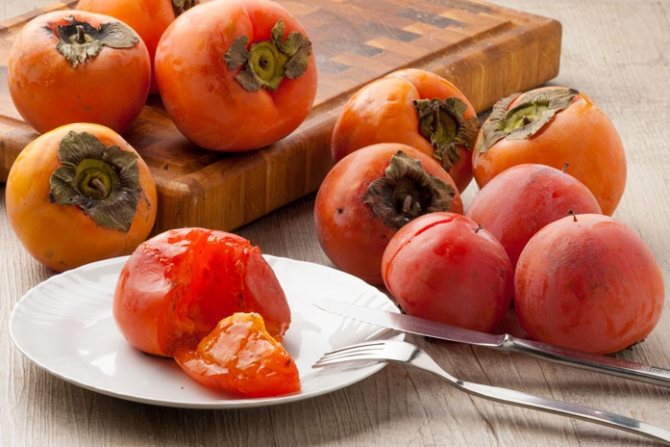
Contraindications
Persimmon (calorie content for weight loss does not exceed acceptable standards, which allows the fruit to be included in a standard dietary diet that includes 1400 kcal) is very healthy in itself, but due to the high tannin content in the unripe fruit, it can stick together pieces of digested food, causing constipation and gastric obstruction.
This makes the fruit prohibited for persons suffering from:
- constipation;
- postoperative abdominal adhesions;
- intestinal atony.
For this reason, the fruit is prohibited from being included in the diet of nursing mothers and children under 10 years of age. Otherwise, the rapid occurrence of intestinal obstruction, caused by the incompatibility of the child’s imperfect intestines and tannin, is possible.
The hypoglycemic index of persimmon is 45-50 units, which classifies it as an average product that is not prohibited for people with diabetes, but a large amount of sucrose forces the consumption of the product to be limited to 1 piece. in Week.
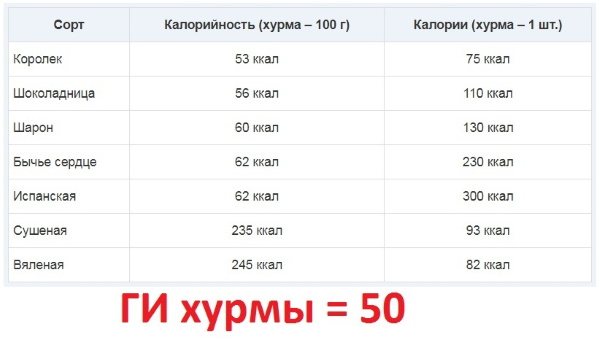
Due to its strong diuretic effect, persimmon is contraindicated for people suffering from kidney and urinary system diseases. You should not eat persimmon if you have an individual intolerance to the fruit.
Composition and beneficial properties
“Korolek” persimmon is rich in fructose, dietary fiber, pectin and many other useful components, due to which it is considered a dietary product. This variety contains vitamins A and C, calcium, phosphorus, magnesium, potassium and iron.
Thanks to all the above qualities, persimmon is used for various medicinal purposes. In folk medicine, it is used to treat edema that occurs due to kidney or heart disease. For people who suffer from obesity, diabetes, and various diseases associated with the gastrointestinal tract, persimmon is very useful for weight loss (its calorie content is low). It helps with anemia, vision and musculoskeletal problems, and also prevents the appearance of kidney stones.
Menu for diet
Persimmon (the calorie content of a fruit when losing weight depends on the variety, but, as a rule, does not exceed 69 kcal) is saturated with pectin and fiber, which allows it to be considered an excellent dietary product.
A snack consisting of 2 fruits will quickly saturate the body and remove feelings of hunger. Based on persimmon, various mono-diets and fasting days have been created, allowing you to lose up to 1 kg per day and significantly reduce body volume. At the same time, and importantly, breast volume can often be maintained.
Fasting days
Based on the predominance of persimmon in the diet, it is possible to remove up to 5-7 kg over a period of 3 to 5 days. The daily diet of such food is very strict and consists of a certain set of products.
Depending on the composition, fasting days differ, consisting of:
- Persimmons and apples. With this diet, you should eat 1 kg of apples and persimmons per day, alternating the consumption of fruits with each other.
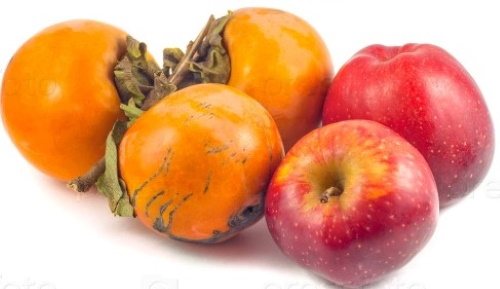
- Persimmon and kefir. Biokefir is consumed up to 1-1.5 liters per day. Supplements the diet with 4 persimmons.
- Persimmon and rice. A very strict diet, lasting at least 5-7 days. Requires a diet consisting of 5 meals, consisting exclusively of 500 grams. rice boiled in water and 1 persimmon.
In addition to these products, you should drink at least 1.5-2 liters per day. water or green tea.
Diet
A combination diet combines daily consumption of persimmons with low-calorie foods. The daily diet with this diet varies from 800 to 1500 kcal per day and is observed for a long time.
Diet rules:
- You are allowed to eat up to 4 persimmons. per day fresh, dried, dried or used as an additive in soups, casseroles and salads.
- The rest of the diet consists only of low-calorie foods, which include: lean meats, fish, poultry, bio-kefir and bio-yogurt, cereals, nuts, vegetables, fruits, eggs.
- Sugar, confectionery, carbonated drinks, alcohol and bakery products are completely removed from the diet.
- The daily drinking ration is at least 1.5-2 liters. water.
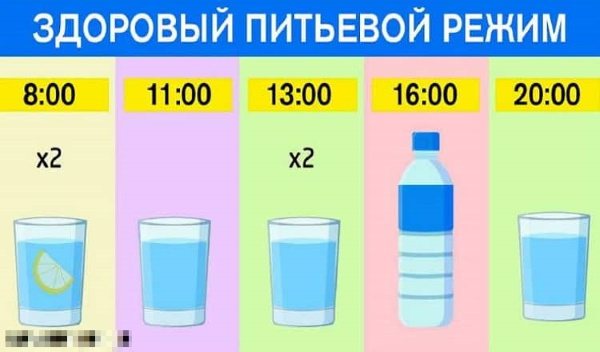
You should stick to this diet for 1 to 3 months.
Sample menu:
| 1st day | |
| Breakfast |
|
| Snack | persimmon |
| Dinner |
|
| Snack | orange |
| Dinner | low-fat cottage cheese with nuts and dried fruits |
| 2nd day | |
| Breakfast |
|
| Snack | persimmon |
| Dinner |
|
| Snack | apples |
| Dinner | baked fish with salad of cherry tomatoes, cucumbers and lettuce |
| 3rd day | |
| Breakfast | curd mass with bio-yogurt and nuts |
| Snack | orange |
| Dinner | steamed minced veal meatballs with rice and grated carrots |
| Snack | persimmon |
| Dinner | pureed persimmon with nuts and honey |
| 4th day | |
| Breakfast | protein steam omelette |
| Snack | persimmon |
| Dinner |
|
| Snack | plums |
| Dinner | salad of persimmon, chicken and feta cheese with sesame grains |
| 5th day | |
| Breakfast | rice casserole with bio-yogurt |
| Snack | persimmon |
| Dinner | soup with persimmon, veal meatballs and zucchini |
| Snack | apples |
| Dinner | fruit salad with persimmons, apples and pears |
| 6th day | |
| Breakfast |
|
| Snack | persimmon |
| Dinner |
|
| Snack | oranges |
| Dinner | Grilled vegetables with lemon juice |
| 7th day | |
| Breakfast |
|
| Snack | persimmon |
| Dinner | chicken pilaf with long grain rice |
| Snack | baked apples |
| Dinner | seafood with vegetable salad |
For faster weight loss, one of the main meals (for example, dinner) can be replaced by eating 1-2 pcs. persimmons
Ducan's diet
Popular 4-stage diet. During the first 2 cycles, eating any fruit is prohibited. During the 3rd day you are allowed to eat one persimmon, apple or 100 grams. strawberries
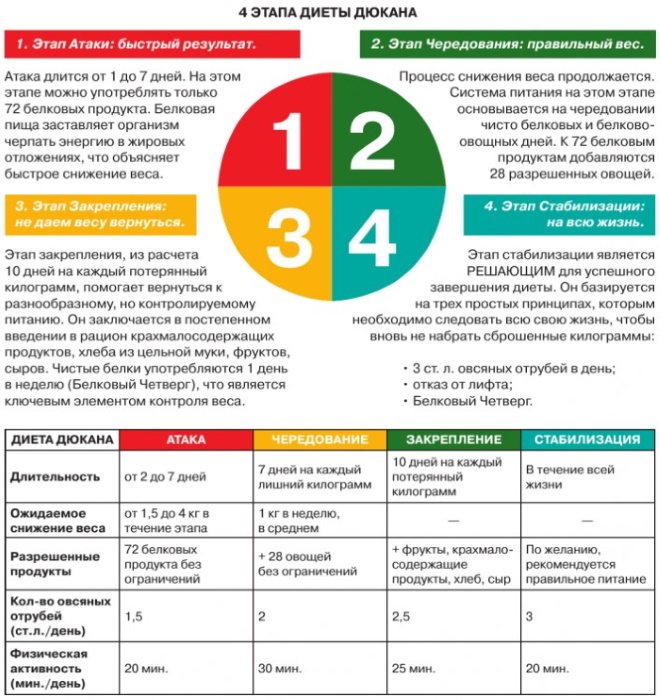
At the 4th stage, restrictions on the amount of fruit are lifted, but the doctor advises eating 2-3 pieces. persimmons until 2 o'clock in the afternoon.
Kremlin diet
Based on assigning a certain index to each product, the diet requires a daily food limit of 20 units. Persimmon, due to its sweetness and large amount of pectin and fiber, is assigned an index of 13, which allows you to optionally introduce it into the diet along with protein products (chicken, fish, veal).
The persimmon variety Korolek is distinguished by the greatest sweetness, appearing on the shelves in November-December.
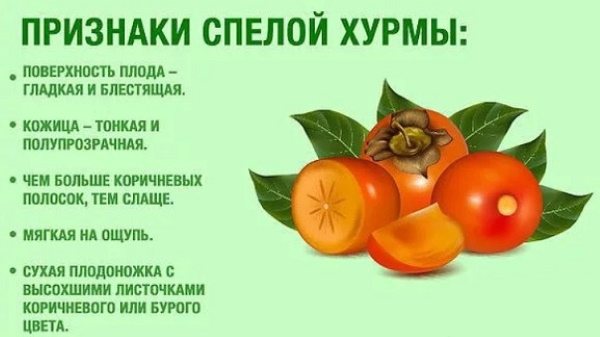
When purchased in a store or market, a ripe and non-astringent fruit has:
- Bright orange color. The light orange hue occurs only in unripe fruits.
- Thin, smooth skin, giving the fruit a resemblance to amber.
- Elasticity. A very dense persimmon is unripe, and excessive softness that falls apart in the hands is a sign of an overripe fruit.
- Dark color of peri-peduncle leaves. When picked up from a ripe fruit, the back of the amniotic leaf has a brown appearance. The unripe one is bright orange.
- Brown circular stripes located on the skin.
- A dried stalk, indicating that an already ripe fruit has been removed from the tree. Persimmons left to ripen are distinguished by a slightly greenish, not withered stalk. Such fruit may not be astringent, but its aroma is significantly inferior to the ripe one.
A distinctive feature of the Korolek variety is its chocolate-colored flesh and the presence of fully formed brown seeds. This sign appears after pollination and is responsible for the maturity and taste of the fruit.
You can't buy persimmons:
- having damage to the skin;
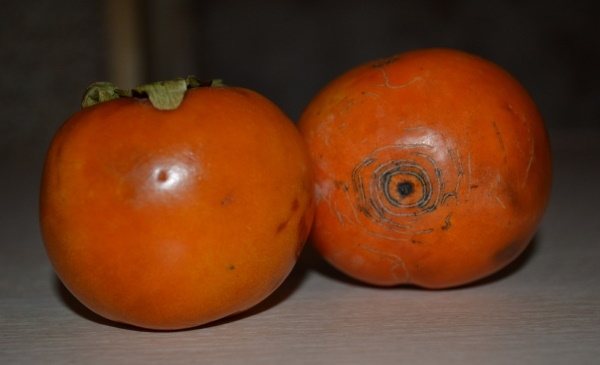
- characterized by the presence of dark, clearly defined spots, considered the first sign of rotting;
- very soft fruits that fall apart in the hands;
Such fruits lie beyond the established expiration date (1.5-4 months) or were brought in violation of transportation rules.
A newly purchased low-calorie product that is actively used for weight loss is stored:
- in the refrigerator for 3 days;
- at temperatures below 0 degrees Celsius and humidity 90% - 2-3 months;
- with quick freezing – 6 months. The same method will help get rid of viscosity.
If you use pantries or cellars to store persimmons, they should be constantly ventilated to avoid the appearance of putrefactive spots.
What can you cook from persimmons?
Usually the fruit is consumed raw, less often dried or dried.
You can prepare persimmons:
- Jam. Suitable for lovers of persimmons and sweets, the main thing is not to overeat.
- Butter cookies. As part of the dish, the fruit will not “knit” and is suitable for those with a sweet tooth. Cinnamon and walnuts go well with it.
- Oatmeal casserole with persimmons. Oatmeal and persimmon are a great combination. Suitable for weight loss and used instead of bars or snacks.
- Jelly. To prepare, the fruit is crushed, gelatin is added, and then the mass is poured into a glass or round mold.
- Chocolate pie. The fruit goes well with chocolate. Cocoa powder and powdered sugar are used for preparation; the recipe is perfect for a holiday.
Persimmon is a healthy and low-calorie fruit. Although it is not dietary due to its high glucose content, it can still be consumed during a diet. In addition, it is much healthier than bananas, grapes and peaches, which are prohibited when losing weight. Like all starchy sweet fruits, it contains a lot of potassium and magnesium, and has a high fiber content. This helps saturate the body for a long time, making you forget about hunger for 3-4 hours. Another advantage of the fruit is its benefits for people with heart problems.
